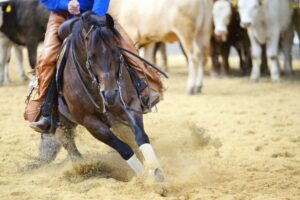Cutting Horse Still Sound 15 Years after VetStem Cell Therapy
At just four years old, Junior, a talented cutting horse, suffered injuries to the suspensory ligaments in both of his hind legs. This type of injury can end the career of even the best performance horses. Fortunately, with the help of his veterinarian, Dr. Martin Gardner of Western Performance Equine, and treatment with VetStem Cell Therapy, Junior made a remarkable recovery. Not only did he return to work, but he went on to have a long, successful career and remains sound nearly 15 years later.
To treat Junior’s injuries, Dr. Gardner recommended VetStem Cell Therapy, a regenerative medicine treatment that uses the horse’s own stem cells to reduce inflammation, promote healing, and repair damaged tissue. A small sample of fat was collected from Junior’s tailhead and sent to VetStem’s lab in Poway, California, where technicians processed it to extract and concentrate his stem cells. Two doses were then shipped back to Dr. Gardner for injection into the injured ligaments. After a 90-day rehab period, Junior gradually returned to work and went on to compete until age 16.
Junior’s owner shared that he’s now 19 years old, still sound, and happily working as a help horse in stock dog trials, calling VetStem Cell Therapy the “best money ever spent on a horse.” Stories like Junior’s highlight how regenerative medicine can give horses a second chance at a full and active life. Thousands of horses like Junior have been treated for tendon, ligament, and joint injuries, allowing many to return to competition and maintain long-term soundness.


